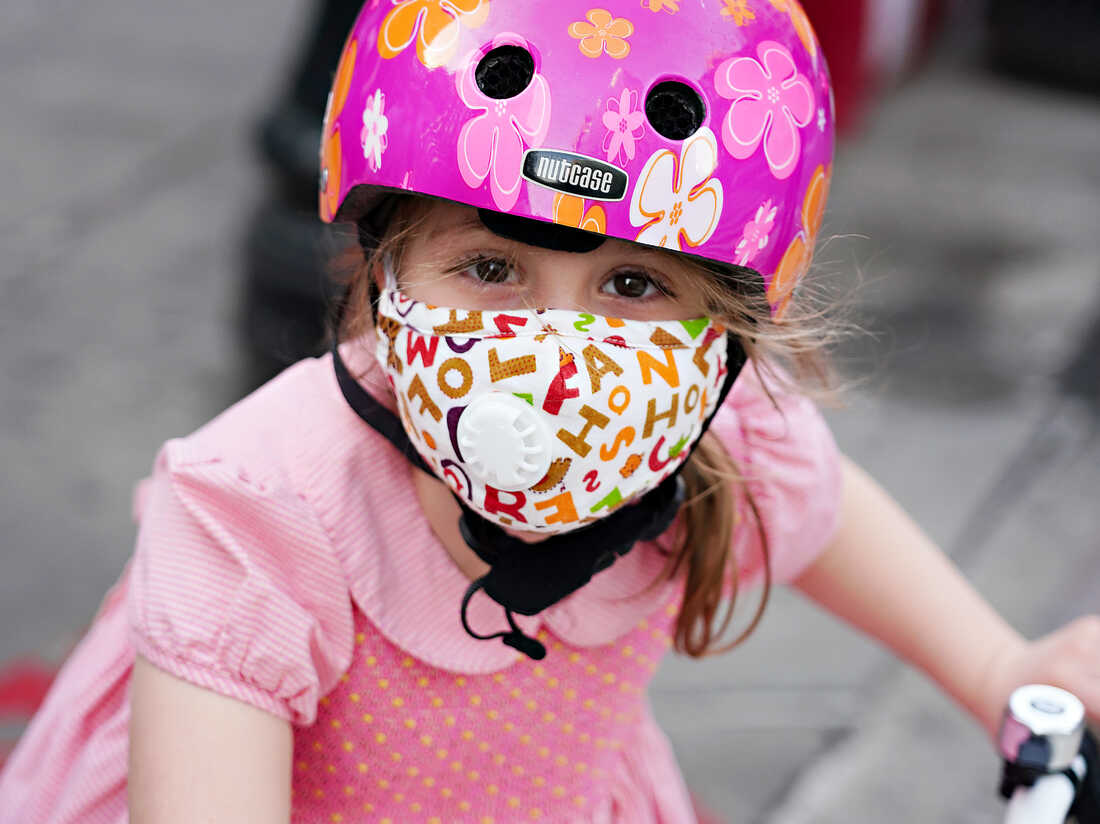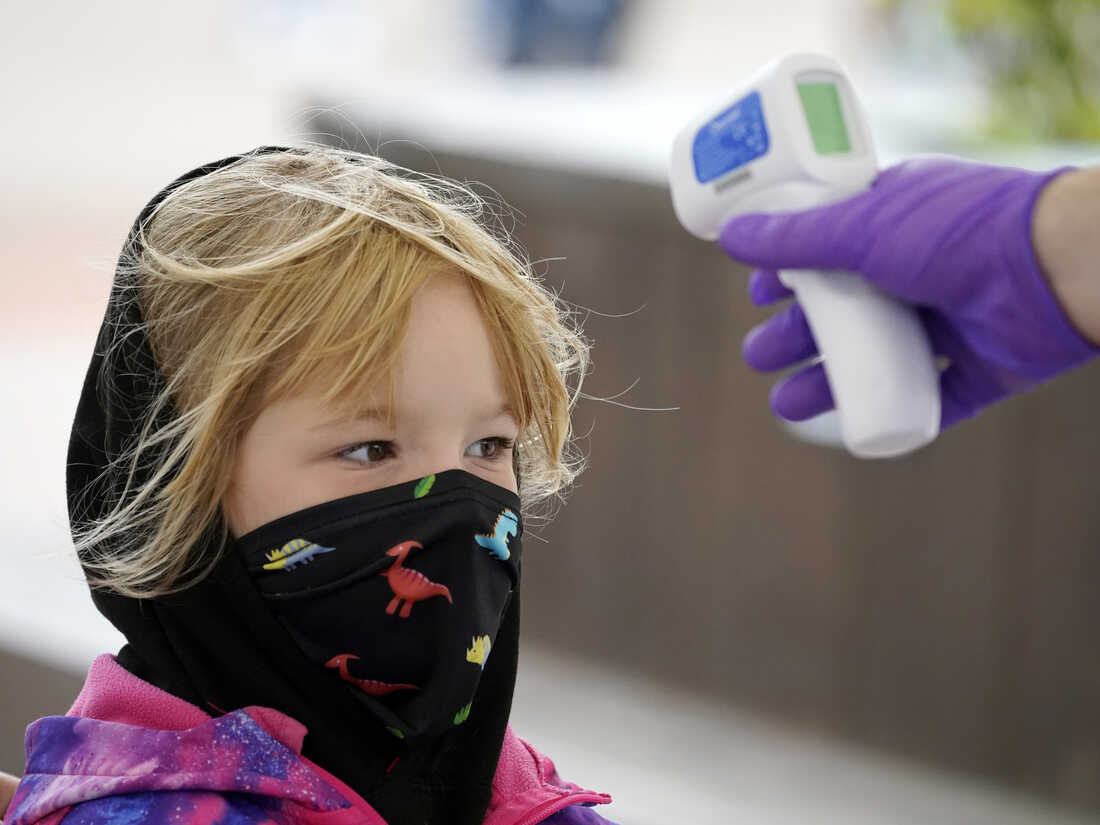
As the pandemic drags on, there are still a lot of questions to be answered about how to keep kids safe.
Cindy Ord/Getty Images
hide caption
toggle caption
Cindy Ord/Getty Images

As the pandemic drags on, there are still a lot of questions to be answered about how to keep kids safe.
Cindy Ord/Getty Images
Amid the omicron surge there is understandable anxiety among parents, particularly those with kids under 5 who can’t yet get a COVID vaccine.
They’re wondering how to navigate life with young children, what this means for travel plans and daycare, and when the vaccine will become available.
Dr. Ibukun Kalu is a pediatric infectious disease doctor at Duke University and says her hospital has already seen a rise in children being admitted.
“Unfortunately, more of the children that are in the hospital are unvaccinated. However, we have younger children that are not eligible for vaccination also end up in the hospital with COVID,” she said.
As the world enters its third year of the pandemic, we asked parents of kids under 5 to send us their questions. Here, Dr. Kalu answers them.
The questions and answers have been edited for length and clarity.
Alex McCarty, Tumwater, WA — 4-year-old daughter and 18-month-old son
Q: What do we know about the severity and risk of the omicron variant to children? Does it seem to be more dangerous than previous variants, is it about the same, or less so?
What we know so far is that omicron is milder in both children and adults. Where in the context of recently dealing with Delta — which was much worse than the virus that was spreading 2020 — omicron is milder than Delta. But it’s still pretty severe, and it can cause significant symptoms in a small group of children, not across the board, but a small subset that do end up with more severe symptoms and end up in the hospital.
In kids, partly because COVID seems to cause the initial infection and then just track through the body and cause post-COVID syndromes, it is worse than influenza. And currently we are seeing influenza spread in our community. But COVID is just outpacing that across the board.
If we see more cases, we’ll likely see a higher number of kids end up in the hospital just by sheer numbers.

Children have become masters at the temperature check.
Christopher Furlong/Getty Images
hide caption
toggle caption
Christopher Furlong/Getty Images

Children have become masters at the temperature check.
Christopher Furlong/Getty Images
Hilary Anderson Carter, Austin, TX — 2-year-old daughter
Q: I have an almost 3-year-old toddler in daycare, and she obviously isn’t eligible for COVID vaccination, but we’ve had several program closures due to exposures to COVID cases in the classroom in the fall semester. And I’m wondering if there are any studies that have been done on the test-to-stay protocols for kids under the age of five?
We do not know enough about test-to-stay in under kids five. And the reason is simple: we approached test-to-stay studies focusing on K-12 environments because they were directly impacted by the quarantine policies that took a ton of kids out of in-person learning. For the daycare setting, pre-school, pre-K, some of the data can be used in those settings, but it’s important to understand the context. Masking behavior may be slightly different in younger kids, and the ability to comply with frequent testing may be slightly different. However, I’m encouraged by the data. It showed that we’ve seen lower transmission within school settings where universal masking exists, and we can continue to promote in-person education for those that find it helpful and can do it through multiple surges in the community.
Ryan McGhie, Lynnwood, WA — 2-year-old son
Q: We had planned a trip to Hawaii, working with our son on mask wearing. But even though he wears his mask reliably, we have concerns with this new variant. Is it safe to take a five hour flight with an unvaccinated 2-year-old, or would it be more prudent to postpone our trip? And once we get to our hotel, how safe is it to go to the beach or to the pools? Should we try to encourage mask wearing while playing in the water?
During the current surge it may be advisable to defer travel since we’ve seen such high rates of community spread. If you can do it, if it’s feasible, push it out a few weeks. If you’re already on the way there, or it’s just not feasible for you to move that around, encouraging masking will be great. I think the 2-year-olds may struggle a little bit. But also ensure that everyone within your party is vaccinated and has received a booster shot if they’re eligible for vaccines. Finally, outdoors is better. We know that transmission of SARS-CoV-2, the virus that causes COVID, is lower in the outdoor setting. So play outdoors as much as you can. Masks don’t necessarily work when you’re submerged in water, so I would not expect masking in that setting.

Many parents have been weighing travel plans over the holidays.
Charly Triballeau/AFP via Getty Images
hide caption
toggle caption
Charly Triballeau/AFP via Getty Images

Many parents have been weighing travel plans over the holidays.
Charly Triballeau/AFP via Getty Images
Alex Benton, Edmonds, WA — 15-month-old daughter
Q: I’m worried that with omicron and other variants that keep popping up, that when the vaccine does eventually get approved for her age group, that is not going to be enough to protect her. Can we expect to be able to sort of resume normal life, let her do some activities indoors with other kids once she’s been vaccinated? Or should we be expecting to wait for a booster?
Once she has been vaccinated, I am pretty sure you can resume normal life. It may depend on what “normal” means. A 15-month-old, for the most part, will not be able to wear a mask. So even today, you can likely resume some level of play or interaction with others, as long as you keep it outdoors and ensure that others that are around are vaccinated. So, yes, you can resume normal life, however you define it, if she is vaccinated. But even today, I think you can start to do some things.
Patti Marriott, Erie, MI — 2-year-old daughter
Q: With the top symptoms for the most recent variant being cold-like symptoms, at what point should we be concerned about testing our child when they are in a daycare setting? We are used to her having a cold one to two times a month. If her symptoms are mild, are we taking away resources from higher-need populations by testing?
I would hope that parents seeking tests for their symptomatic children are not taking away resources from adults that are also symptomatic or immunocompromised. I think if the daycare is either having a cluster of cases, or just symptomatic kids, it may be helpful to get the child that’s in daycare tested just to assess if they have COVID. Just note we’re solidly in the middle of the respiratory viral season, which means that particularly for our kids in daycare, they could get a different viral infection every month, and you likely don’t need to test them each time. But COVID is here and COVID is spreading and certainly can spread within daycare, so if you have access to tests and you have a child with new symptoms, it might be worth testing them for COVID.

Everything from daycare to pre-k and school has been disrupted by COVID.
Christof Stache/AFP via Getty Images
hide caption
toggle caption
Christof Stache/AFP via Getty Images

Everything from daycare to pre-k and school has been disrupted by COVID.
Christof Stache/AFP via Getty Images
Oriana Perez, Houston, TX — 3-year-old daughter
Q: What was the reason the Pfizer vaccine trial for children under five failed?
What I understand about the process so far is that the trial was conducted to ensure that the vaccine is safe and it actually works, so that it’s effective in children younger than five. And the dose that was chosen did not necessarily trigger a high enough protective response. They were advised, and they chose to go back and adjust the dose to ensure that when they have a viable vaccine option, the dose that’s authorized will likely lead to a protective response in kids. So, I didn’t see it as a failure. I think this is a good and helpful process for getting a safe and effective vaccine, although it does extend the timeline slightly and it just creates a little bit of concern as we’re dealing with the omicron surge and still don’t have a viable option for our youngest kids.
Mandy McCaslin, Seattle, WA — 6-month-old son
Q: How much research has been done for the babies who were in utero when moms were vaccinated, or babies who were breastfeeding when moms are vaccinated? How protected are they since they can’t wear a mask and can’t be vaccinated themselves?
The CDC has summarized some of the more recent research, and I will refer to the data they’ve shared publicly as the source of information that may be helpful here, but there are also multiple published studies from 2021 that help to address the question. Specifically, when they look at mothers that had babies recently, mothers that were vaccinated or those that may have been unvaccinated but got an infection just by nature of having COVID spreading everywhere, they saw that those who were vaccinated were able to pass antibodies or pass protection onto the infant. And pass it in such a way that it was both in the blood, but also within the mouth and nose, so within the mucosa layer of the babies. And this is huge. This is great. Because if babies get exposed just inadvertently in the community, they have a layer of protection since they can’t mount their own protection. Some of those who were infected passed some antibodies as well, but it was slightly less than those that were vaccinated. So I think vaccines are safe and effective in pregnant women, and they were able to pass it on, which is hugely helpful.